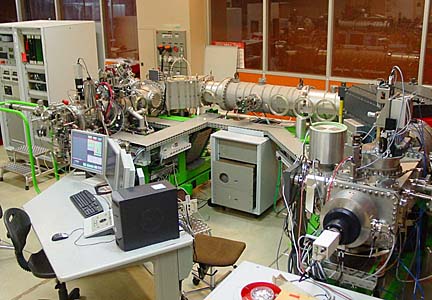
|
Lab to write
solar history
A $1.5 million grant gives UH researchers
the tools to analyze bits of cosmic dust
The University of Hawaii is developing one of the world's most advanced laboratories to study the origin of the solar system.
"The university is trying to build the premier center in the world for studies of primitive materials, cosmic dust, meteorites and samples from other planets," said Peter Mouginis-Mark, acting director of the Hawaii Institute of Geophysics and Planetology.
The UH Foundation received $1.5 million from the W.M. Keck Foundation to create the new lab, which uses an array of sciences called cosmochemistry to analyze bits of meteorites, planets and comet dust. UH matched it with $1 million, and NASA approved $1.4 million to acquire a state-of-the-art ion microprobe for the laboratory, Mouginis-Mark said.
The instrument is being built in France, he said. "It's huge. I'm not even sure how we're going to get it into the (Pacific Ocean Science and Technology ) building, but we'll find a way."
Klaus Keil, interim dean of the School of Ocean Earth Sciences and Technology, said the UH research group will "really make a quantum leap forward in the field of cosmochemistry."
Joining the group are two world experts in ion microprobe analysis and cosmochemistry: Gary Huss, formerly of the University of Arizona, and Kazu Nagashima, formerly of the Tokyo Institute of Technology.
Huss said, "What we're going to do is look at samples from the earliest solar system, which are mostly meteorites but will include comet dust from the Stardust Mission to the comet, and samples from the moon and potentially samples from Mars, and we will investigate how they formed."
Meteorites and comets probably date from the earliest times of the solar system, he said, "so when we look at those, we see the very earliest building blocks of the solar system, and we have the ability to investigate processes that occurred in the early solar system."
The main advantage of the ion probe is they can measure samples without having to dissolve or destroy them, he said. "We can measure spots on polished samples only a few microns across.
"We investigate the materials, processes and timing of events in the early solar system to try to piece together the story of how the solar system formed."
Huss said some of the raw materials for the early solar system are "surviving grains that formed around other stars at the end of their lives. The elements heavier than hydrogen and helium were produced by nuclear processes in stars, and they are dispersed through the galaxy when a star either ejects its envelope or explodes at the end of its life."
The scientists can investigate the timing of events in the early solar system with the ion probe, he said, adding, "We now know that the formation of bodies the size of the current asteroids took only a few million years after the solar system began and that the earth formed shortly thereafter."
UH-Manoa Chancellor Peter Englert said the Keck Foundation award "highlights both the quality and range of research expertise at the university and is a testament to our growing reputation within the international scientific community."
The Institute of Geophysics and Planetology has a renowned group of scientists studying meteorites and data from Mars and other planets.
Their program has been involved with present and planned spacecraft missions that will return samples, such as Genesis, Stardust and Mars sample return programs.
The program also provides critical information for interpretation of remote sensing data and addresses questions posed by materials obtained from deep interiors of stars or planets.
www.hawaii.edu
E-mail to City Desk
[News] [Business] [Features] [Sports] [Editorial] [Do It Electric!]
[Classified Ads] [Search] [Subscribe] [Info] [Letter to Editor]
[Feedback]
